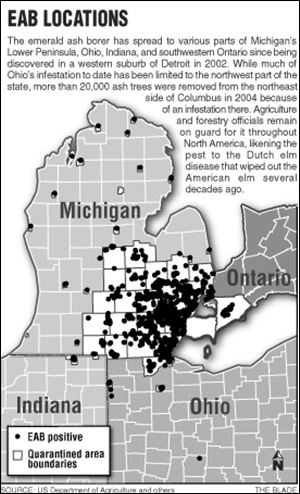
Insecticides offer hope for control of ash borer
4/7/2005
MONROE - While the emerald ash borer continues to dig in as one of this generation's greatest forestry threats, no breakthroughs for stopping the invasive pest from Asia appear in sight.
To the chagrin of some tree-loving landowners, officials continue to stick to the U.S. Department of Agriculture protocol of removing healthy ash trees within a half-mile of infested ones to remove the tiny beetle from its food source in hopes of stopping it in its tracks.
As a result, millions of trees in Michigan, Ohio, Indiana, and Ontario have been cut down or marked for removal.
But at a public forum at Monroe County Community College last night, research presented by Michigan State University gave a glimmer of hope for a chemical treatment that could stop the carnage, or at least buy North America time to seek a cure.
An MSU entomologist, Eric Rebek, said insecticides with an active ingredient called imidacloprid have shown promise for homeowner applications. He identified two Bayer products: Bayer Advanced Tree and Shrub Insect Control, used for prevention by "drenching" the tree trunk, and Bayer Advanced Multi Insect Killer, for trying to kill adult emerald ash borers after they've become established.
But he and others cautioned that no insecticide is seen as a cure. MSU is researching various options, including dosage of those products and others, Mr. Rebek said.
Even if the day comes when scientists feel they have found an insecticide that gives them enough confidence to scale back on massive tree cuts, a policy debate will have to be resolved.
Both the Ohio Department of Agriculture and Ohio State University are reluctant to go the route of insecticides, Amy Stone, an OSU extension agent in Toledo, said. "We don't encourage homeowners to use insecticides," she said. "Nothing out there is 100 percent, and that's what we want."
Ohio's loss of ash trees is in the thousands, while Michigan's is in the millions. But Ohio has far more ash trees: 3.8 billion to Michigan's 700 million. Ohio also has a number of jobs dependent on a tool-handle industry that uses ash wood.
"We're just a fingerprint in the whole problem of this insect. We're hoping to eradicate it before it spreads across North America," Ms. Stone explained.
The ash borer has been called the biggest threat to a tree species since Dutch elm disease wiped out the American elm decades ago. Dutch elm disease began in Cleveland in 1930. By the 1960s, the elm - one of the nation's most popular shade trees - was virtually gone.
"Diversify, diversify, diversify," said Robert Gentry, Adrian parks and forestry superintendent. He said Americans apparently didn't learn that lesson from the elm and now will learn it again the hard way from the loss of the ash. Ironically, ash trees replaced many elm trees as shade trees.
The emerald ash borer is believed to have been imported to Michigan's Canton Township, west of Detroit, in the mid to late 1990s in a wood crate shipment. By the late 1990s, ash trees in that township were dying, officials said.
About 28 million trees in six southeast Michigan counties are dead, threatened, or have been removed.
Monroe County thought its problem could be confined to its northern half. But survey results from last year's first trapping program confirmed the worst suspicions: The beetle has infested trees as far south as Erie, Bedford, and Whiteford townships, said Jennie Stanger, MSU extension agent in Monroe. "We are now concluding this insect had already moved through Monroe County and into Toledo," she said.
It is not believed to move naturally more than a half-mile a year, but has received a boost from people who illegally or unknowingly moved contaminated firewood, officials said.
The movement of firewood is believed to be a reason why the pest has been found east of a massive clear-cut in southwest Ontario, where a band of 84,000 ash trees several miles wide was removed between Lake St. Clair and Lake Erie in early 2004. The swath was cut to try to keep the pest from invading other parts of Canada.
Contact Tom Henry at:
thenry@theblade.com
or 419-724-6079.